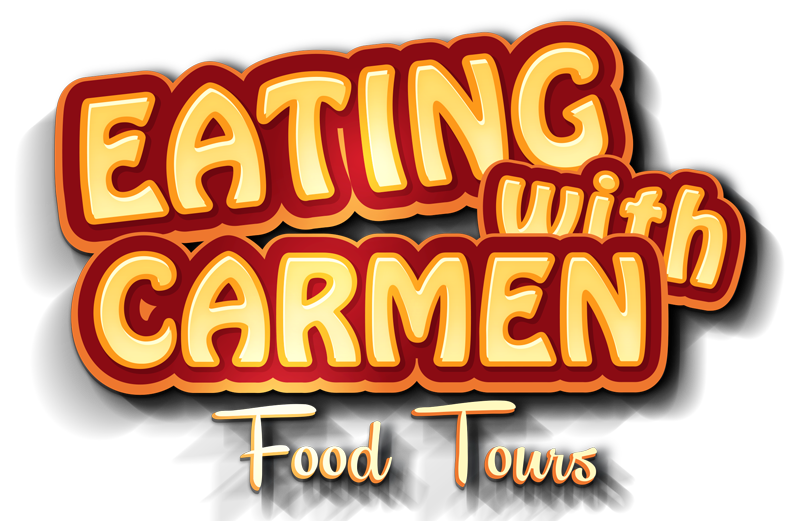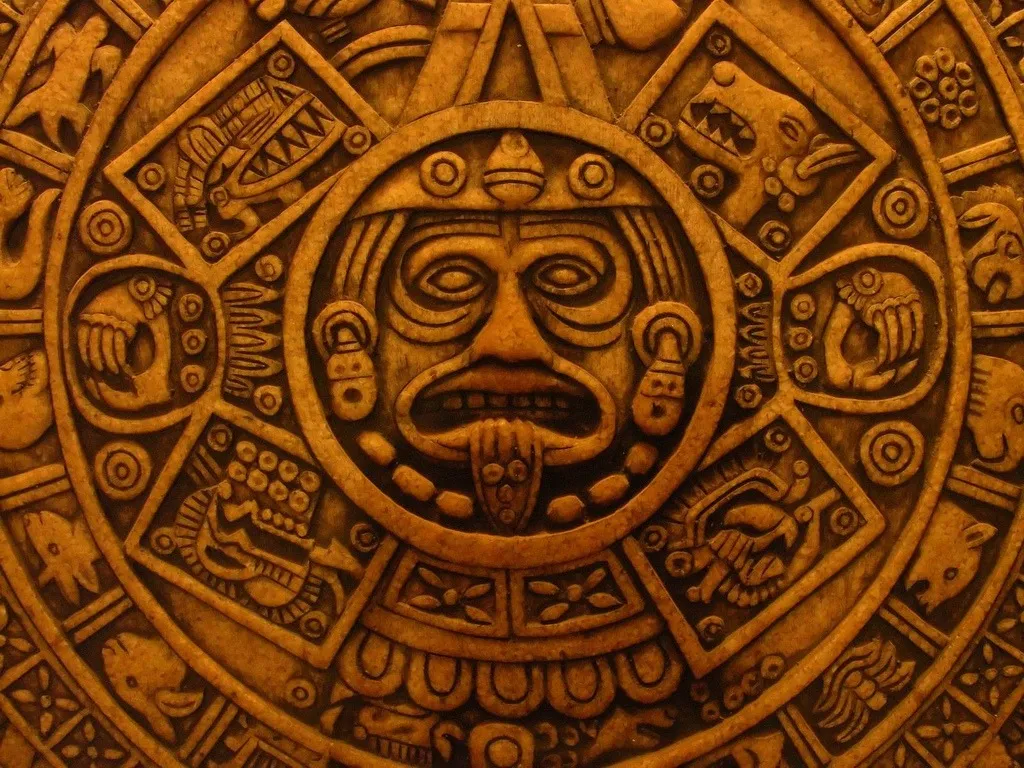Hola my curious foodies! So often on our tours, people get confused between Mayans and Aztecs. When coming to the MAYAN Riviera it is inevitable to be curious about Mayan Civilization, however, if we’re talking about MEXICAN culture, it’s very important to talk about The Mexica (Aztec) Empire.
So my friends it’s time to dust off the codices and old books and bring back to life all those legends and myths around The Ancient Mayans and The Mexica Warriors.
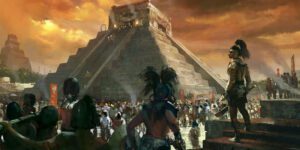 Source: https://mexicanroutes.com/
Source: https://mexicanroutes.com/
It is admirable how Mayas, as a 2,600-year-old civilization, although they did not have sophisticated instruments or devices, were pioneers in mathematics, natural medicine, agriculture, writing, and art.
On the other hand, the Mexicas (Meh-she-cahs) faith and tenacity lead them to raise great cities, pyramids, and temples as a tribute to their gods and one of the biggest pre-colonial empires. Agriculturists, herbalists, conquerors, and astronomers with ideas of their own and some others taken from Mayas and many other ancient civilizations.
Two totally different civilizations located in different time and space. Without a doubt, one of the most representative of the history of our country and our present civilization.
Let’s figure out who’s who and what happened where.
ANCIENT TERRITORIES
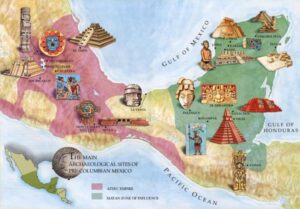 Source: Angelhill.org
Source: Angelhill.org
The Maya civilization spread through much of southeastern Mexico, in Yucatán, Campeche, Quintana Roo, and portions of Chiapas and Tabasco, Belize, central and northern Guatemala, and the northwestern border of Honduras. The most important City-states were Chichén Itza, Tikal, and Copán.
As for Mexicas, in over a century, they extended their domains to what we know today as Ciudad de México, Estado de México, Veracruz, Puebla, Hidalgo, Morelos, Michoacán, part of Guerrero and Oaxaca, the coast of Chiapas and even the border with Guatemala.
MAYANS
The Mayas, between the 3rd and the 5th centuries of our era, occupied the Yucatan Peninsula and its surroundings, and built majestic pyramids and temples where the first Mayan cities were built.
They organized their lives based on astronomical predictions known to the priests. They were able to look at the Sky and analyze the universe to unravel astronomical calculations. Their cosmology was based on the Milky Way, which they called Wakah Chan. They had their own solar calendar and knew the regularity of eclipses.
Much of Mayan history and culture was lost due to the massive burning of its books in 1562. Fortunately, the Mayan religious text, Popol Vuh, survived to give historians an understanding of more than 250 deities Mayas worshiped.
Many of the Mayan gods and goddesses participated in all aspects of life and some of the most important continue to be worshiped today.
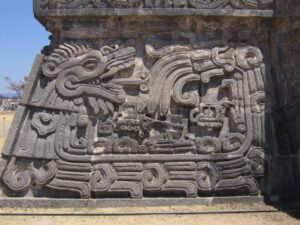
Source: https://mxcity.mx/
Kukulcan: The Feathered Serpent, God of Water, Wind, and one of the three main gods believed to have created the world and human beings.
Itzamná: God of Heaven, considered the founder of the Maya culture, patron and protector of the sciences, astrology, and writing. A healer who could also raise the dead.
Ix chel: Goddess of the Moon and crops, defended fertility, marriage, and love. It had power over lunar cycles.
It was believed that Mayas were peaceful people, but the mural paintings of Bonampak found in Chiapas in 1946, prove quite the opposite. The reality is that Maya society was involved in numerous bloody struggles in which prisoners were tortured and then offered to the gods as human sacrifices.
Many relate the end of the Mayan civilization to the Conquest. However, what remained of the Mayan civilization, located in the south of Mexico, continued to fight for almost 200 years. According to historians, the long periods of drought, little by little, were weakening much of its population along with its strong armies.
MAYAS: SOCIETY & POLITICS
During the Postclassic period, Mayas were divided into cities, each led by a noble family, mostly spending their time fighting each other. The city of Mayapán managed to dominate many cities through a complex network of marriage alliances.
Leading Mayapán was the Halach Uinik, a kind of king, emperor, monarch, prince, or great lord, according to the Maya testimonies themselves. Under the Halach Uinik were several officials who administered severe justice, collected tributes from the peasants and controlled the activities of the population.
Postclassic Mayan society was organized hierarchically where four social classes were distinguished: nobles, priests, commoners, and slaves. Military leaders played a key role in the wake of the importance of war in these centuries.
CULTURAL CONTRIBUTIONS
In the field of mathematics, they developed a vigesimal numbering system structured on the basis of three signs: the point, the stripe and the snail. The value of each of these was equivalent to one, five and zero respectively. The position of each sign and its combination with the others determined its final value.
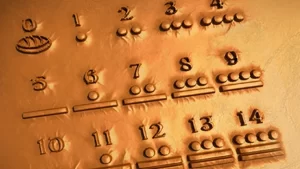 Source: https://expansion.mx/
Source: https://expansion.mx/
They developed a writing system composed of more than 800 glyphs, that is, of signs that mostly expressed ideas, but also, some of them, phonemes.
With full knowledge of their stories told from generation to generation, the Maya began to settle the concept of written history, so they began to record the exploits of their gods, everyday life, and news on walls and pillars.
The Maya excelled in sculpture and engraving above all their ancestors and enjoy worldwide recognition for their details in the finishes. It had a different and modern style for the time, full of beauty and color. Precious metals were scarce so they were only used for exclusive designs, being more common as jade, obsidian, stone, bone, stucco shells and wood.
FROM AZTECS TO MEXICAS
 Source: https://mxcity.mx/
Source: https://mxcity.mx/
According to some historical documents such as the Boturini Codex, a group of Aztec tribes, illuminated by the god Huitzilopochtli, left the city of Aztlán, which was being repressed by the Aztecs of Chicomoztoc and began a hunt for a promised land. Becoming the ancestors of the Mexica civilization.
When they arrived at Mexico Valley, Mexicas found themselves with a complex political landscape already established with several cities. After being repeatedly defeated by every tribe they crossed paths with, by 1280 they arrived at Chapultepec, settling for almost 19 years until they were expelled by the Chalcas and the Xochimilcas.
At this point, going through terrible living conditions, Mexicas lost hope to find the so-called promised land or any prophecy whatsoever. Finally, in year 2 Calli or 1325, on a small island on Lake Texcoco, they witnessed the sign that their god Huitzilopochtli had promised, an eagle devouring a snake above a nopal. And so they established there, the great city Mexico-Tenochititlán. (Mexico City)
The Grand Tenochtitlan was settled on six lakes which were unified during the rainy season and constituted Lake Texcoco, rich in reeds and aquatic fauna, migratory birds, and small mammals, which allowed them sustenance, as well as a military and strategic position. Although in the first years their living conditions would be precarious, over time, their economy and politics became more organized and the city flourished.
A CONQUERING EMPIRE
Battles were constantly concentrated in or around the big cities, the victors claimed all the surrounding territory. Regular tributes were drawn, and prisoners were taken to Tenochtitlan for ritual sacrifices. In this way, the Mexica Empire came to cover most of the Anahuac, or land between the waters, an area in northern Mesoamerica in Mexico, around 135,000 km2. (Over 52,000 square miles)
The steady tide changed when the Mexica were heavily defeated by Tlaxcala and Huexotzingo in 1515 and later by the conquistadors, led by Hernán Cortés.
In the beginning, the relationship between the Mexica leader, Moctezuma Xocoyotzin and Cortés was a friendly one, exchanges of valuable gifts were made to build this relationship.
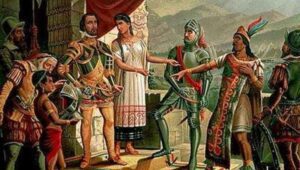 Source: https://www.unionpuebla.mx/
Source: https://www.unionpuebla.mx/
However, things changed when a group of Mexica warriors, murdered a group of Spanish soldiers. Unhappy with Moctezuma’s passivity, Cuitláhuac overthrew him and established himself as the new Tlatoani (Emperor).
This incident was just what Cortés needed, he returned ten months later and in 1521 laid siege to the city. Without food, devastated by diseases brought by the Europeans, Mexicas, now led by Cuauhtémoc, finally collapsed on the fateful day of August 13, 1521. Tenochtitlan was looted and its monuments destroyed.
And just like that…the long line of Mesoamerican civilizations, dating back to the Olmecs, came to a dramatic and brutal end.
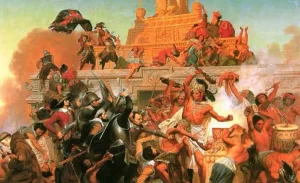 Source: https://www.infobae.com/
Source: https://www.infobae.com/
MEXICAS: SOCIETY & POLITICS
The Mexicas, by establishing themselves and evolving as a human group, created the most sophisticated social and political organization in Mesoamerica, resting on the idea that the forces that give energy to the cosmos were manifested in the rulers, who represented the different forces accumulated by the gods.
The man who occupied the supreme position among all the chiefs was called Tlacatecuhtli (lord of men), also called Tlatoani.
Groups of 20 clans or families formed Calpullis, which were assigned an area of arable land where the inhabitants shared the work of harvesting those lands. The heads of the household elected a representative (Calpullec), advised by a council of elders (Huehuetque). The representatives of each Calpulli, formed the Tlatocan, a very important organism in the general government of Grand Tenochtitlan.
Nobility was the tip of the social pyramid of the Mexica culture, from the nobles (pipiltin) came the ruler of the Altepetl (lordship or city) followed by priests, artisans, commoners, peasant serfs, and slaves.
CULTURAL CONTRIBUTIONS
Historically, education was not mandatory in the world, but this is something that represented the Mexicas, this civilization was in the vanguard presenting an imposed and free educational model, which did not distinguish between gender or social classes.
Although children, up to the age of 14, were educated by their parents, such education was supervised by the authorities of their calpulli. These classes included learning the collection of sayings that represented Mexica ideals.
There were two types of schools: the “telpochcalli”, for practical and military studies, and “calmécac”, for specialized learning in writing, astronomy, theology and leadership.
 Source: https://foodandwineespanol.com/
Source: https://foodandwineespanol.com/
Their agriculture was admirable. The Chinampa, from the Nahuatl chinampan, is a Mesoamerican method of agriculture and territorial expansion used by Mexicas to expand the territory on the surface of lakes and lagoons of the Valley of Mexico.
The chinampa is an artificial system of cultivation that is built in areas where water is the main natural resource. They are built in order to grow plants, and vegetables for self-consumption and local markets. Among the vegetables that were produced under this system, we can find spinach, chard, radishes, parsley, coriander, cauliflower, celery, peppermint, kohlrabi, chives, rosemary, lettuce and purslane, among others.
This chinampa is placed in shallow areas of lakes and does not depend on artificial irrigation or rainwater, because its location always has irrigation.
With the urbanization of Mexico City, the chinampería was lost, with the exception of Xochimilco which still practices this tradition.

Source: https://mxcity.mx/
Talking about these two great civilizations can take a while, we are talking about centuries and centuries of evolution, wars, gods, and a whole lot to discover. But I don’t want to make this tremendously long.
It’s up to YOU when visiting our México lindo y querido, to soak up the magic of these cultures. When you explore the ruins and temples, transport yourself to those moments when our ancestors were hunting for the stars or watching how some “warriors from another world” change the course of civilization forever.
And when you eat our delicious authentic food, remember the ancestral cultures that made these flavors possible. Eating With Carmen Food Tours has everything you need for your next visit to the Riviera Maya. Let us guide you, either through our food tours, so you can try some of the delicacies that our Mayan ancestors ate or check out our latest post where you can always find something to learn about this wonderful country, through its culture, its food and its history.
-Abbey, the geeky foodie.
